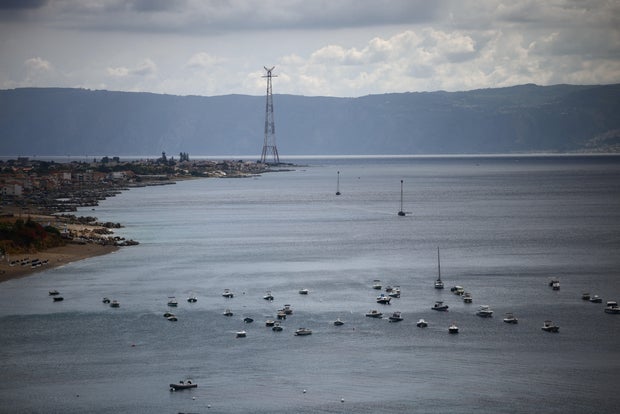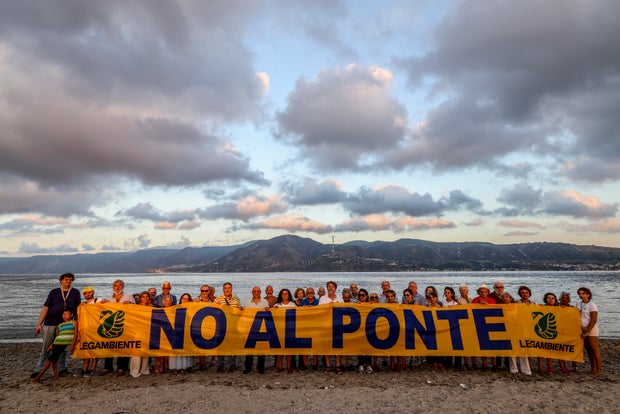A long -delayed bridge and discussion has been reduced by the Italian mainland with Sicily, a big obstacle on Wednesday, allowing work to start what could be the longest suspended bridge in the world, despite fears of earthquakes and environmental effects and threatening the mafia overlap.
The Ministry of Transport said in a statement that the Bentertic Committee, while supervising the strategic public investments, agreed to the project of 13.5 billion euros (15.5 billion dollars). Transport Minister Matteo Salvini said the project will be “speeding up development” in southern Italy.
Initial work can start later this summer, as construction is expected to start next year, as the French News Agency indicates, to the completion of the completion in 2032.
Yara Nardi / Reuters
The Messina Bridge Strait has been approved and canceled several times since the Italian government first requested proposals in 1969 and was recently revived by the administration of Prime Minister Georgia Meloni in 2023. The idea of building a link between Sicily and the dates of the mainland to ancient Rome.
The decision represents a political victory for Silvini, who achieved the bridge a distinctive feature of his term, saying that it will be a “revolution” for southern Italy by bringing jobs and economic growth.
The Missina Bridge Strait will reach about 3.7 km (2.3 miles), with a stop -executing financing of up to 3.3 km (about two miles), bypassing the Canaakil Bridge in Turkey, which is longer, 1,277 meters (4,189 feet). With four passages of traffic surrounded by a double -track railway, the bridge will have the ability to carry 6000 vehicles per hour and 200 trains per day.
The controversy continues
AFP notes that some critics believe that it will never be built, pointing to a long history of public works that have been announced and funded, but still ends in Italy.
The project can provide a boost for Italy’s commitment to raising defensive spending to 5 % of the GDP targeted by NATO, as the government indicated the classification of the bridge as related to defense, which helps it to meet a 1.5 % security component. Italy argues that the bridge will constitute a strategic corridor for the movements of fast forces and the deployment of equipment on the southern wings of NATO, which qualifies it as a “security infrastructure”.
A group of more than 600 professors and researchers signed a letter earlier this summer opponents of military classification, noting that such a step requires additional assessments to see if it could stand up to military use. Opponents also say the appointment will make the bridge target.
Environmental groups submitted additional complaints with the European Union, noting that the project will affect migratory birds, noting that environmental studies have not shown that the project is a general necessity.
Gety pictures
The original government decree reactivated the bridge project, the language of giving control of the Ministry of Interior to control measures. However, the president of Italy insisted that the project remains subject to anti -combating legislation that applies to all infrastructure projects on a large scale in Italy out of concerns that the designated arrangement will weaken controls.
The project was granted to a consortium led by Webuild, a group of Italian infrastructure that initially won the construction of the bridge in 2006 before the project was canceled in 2013. WeBUILD built the Canakkale Bridge, which is currently the longest suspension bridge two kilometers and 23 meters (about a quarter and a quarter).
The Canakkale Bridge, which was opened in 2022, was built using the engineering model that was originally developed for the Messina Bridge, with a wing profile and a deck shape resembling the fountain fountain fighter with holes to enable winds from passing through the structure, according to Webious.
Treating concerns about building the bridge on Missina’s mistake, which led to a deadly earthquake in 1908, Webuild confirmed that the suspension bridges are less likely to be the structural standpoint of seismic forces. He indicated that such bridges were built in earthquake -active areas, including Japan, Turkey and California.
The CEO of Webuild Pietro Salini told investors this month that the Messina Bridge “will be a game change for Italy.”
https://assets1.cbsnewsstatic.com/hub/i/r/2025/08/06/4c3aebdc-0628-42f5-bb8c-aa1b522228e2/thumbnail/1200×630/f5c0c28e339f984cb1e61a8a72c8cc82/2025-08-05t172342z-1858307043-rc2x0ga0t1ba-rtrmadp-3-italy-bridge.jpg
Source link

